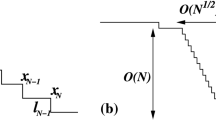Abstract
The structure and energetics of ledge pairs (atomic steps) in surfaces \( (0001),\,(10\bar 10),\,(1\bar 210) \) of hcp Zr and Ti are studied by computer simulation using embedded-atom-type interatomic potentials. The configurations considered are the face-to-face, back-to-back, sequential, and double, according to their cross-sectional view. Ledge and kink formation and interaction energies are obtained. Vacancies and adatoms are introduced to study their formation and migration energies in interaction with the ledges. But for one case (surface \( (10\bar 10) \)) it is found that ledges are preferred sites for vacancy and adatom formation; also, their overall effect on diffusion is predicted to be small. The results indicate that the effect of ledges can be neglected beyond a few atomic distances.








Similar content being viewed by others
References
Burton WK, Cabrera N, Frank FC (1951) Philos Trans Royal Soc 243 A:299
Gjostein NA (1967) In: Burke JJ, Reed NL, Weiss V (eds) Surfaces and interfaces. Syracuse University Press, New York, p 271
Adda Y (1996) In Philibert J, Sabioni ACS, Dyment F (eds) Difusão em Materiais. Revista Escola de Minas Press, Ouro Preto, p 267
Willaime F, Piquet Y, Legrand B (2001) Defect Diffus Forum 194–199:1381
Wynblatt P (1972) In Gehlen PC, Beeler JR, Jaffee RI (eds) Interatomic Potential and simulation of lattice defects. Plenum Press, New York, p 633
Shilkrot LE, Srolovitz DJ (1996) Phys Rev B 53:11120
Liu Ch-L, Adams JB (1992) Surface Sci 265:262
Liu Ch-L, Adams JB (1993) Surface Sci 294:211
Nelson RC, Einstein TL, Khare SV, Rous PJ (1993) Surface Sci 295:462
Villarba M, Jónsson H (1994) Surface Sci 317:15
Ferrando R, Tréglia G (1997) Surface Sci 377–379:843
Máca F, Kotrla M, Trushin OS (1999) Vacuum 54:113
Chen SP (1992) Surface Sci 264:L162
Fernández JR, Monti AM, Pasianot RC (1997) Philos Mag B 75:283
Dulub O, Boatner LA, Diebold U (2002) Surface Sci 519:201
Fernández JR, Pascuet MI, Pasianot RC, Monti AM (2001) Defect Diffus Forum 194–199:1375
Pascuet MI, Pasianot RC, Monti AM (2001) J Mol Catal A: Chemical 167:165
Pascuet MI, Fernández JR, Pasianot RC, Monti AM (2003) Interface Sci 11:121
Fernández JR, Monti AM, Pasianot RC (1996) J Nucl Mater 229:1
Pasianot RC, Monti AM (1999) J Nucl Mater 264:198
Máca F, Kotrla M, Trushin OS (2000) Surface Sci 454–456:579
Feibelman PJ (1998) Phys Rev Lett 81:168
Kyuno K, Ehrlich G (1997) Surface Sci 394:L179
Schwoebel RL (1966) J Appl Phy 37:3682
Pascuet MI (2003) PhD Thesis, Universidad Nacional de San Martín, Buenos Aires
Jeong H-C, Williams ED (1999) Surface Sci Rep 34:171
Wang Z, Li Y, Adams JB (2000) Surface Sci 450:51
Acknowledgements
Financial support from Agencia Nacional de Promoción Científica y Tecnológica through subsidy PICT-1206164 is gratefully acknowledged.
Author information
Authors and Affiliations
Corresponding author
Rights and permissions
About this article
Cite this article
Pascuet, M.I., Pasianot, R.C. & Monti, A.M. A computational study of hcp Ti and Zr stepped surfaces. J Mater Sci 41, 6207–6214 (2006). https://doi.org/10.1007/s10853-006-0363-6
Published:
Issue Date:
DOI: https://doi.org/10.1007/s10853-006-0363-6



